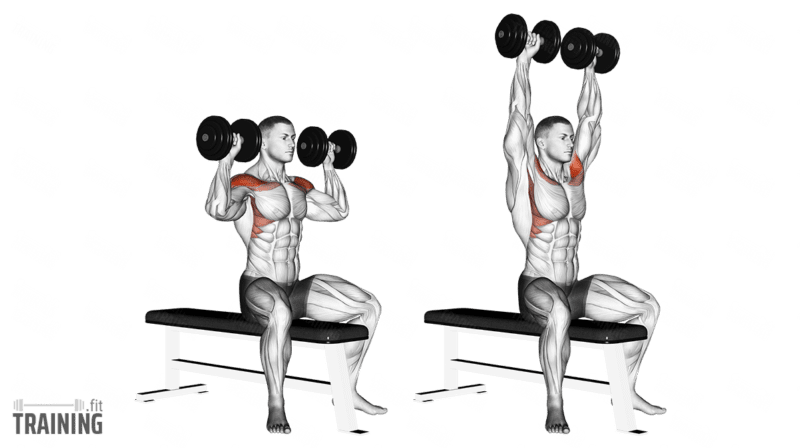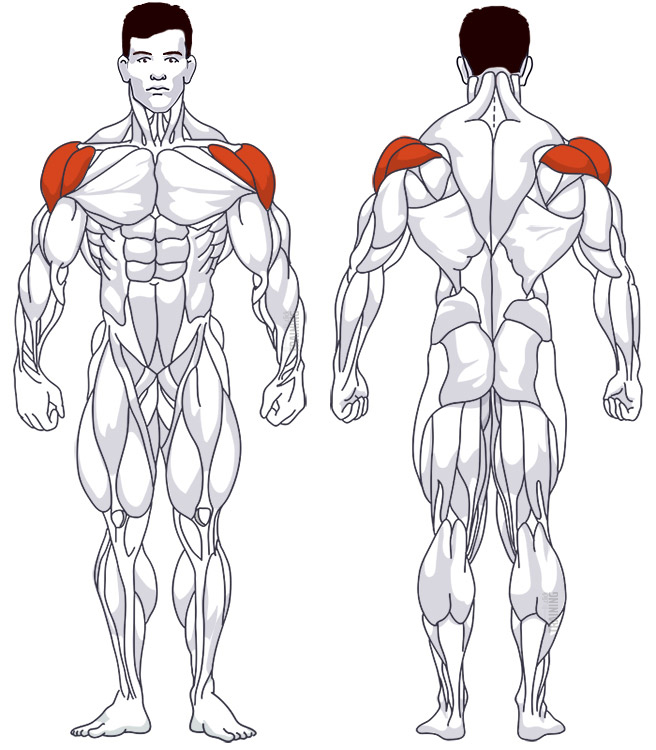Dumbbell Shoulder Press
Isolation exercise, Free weightsThis article is verified by 1 study/publication.
Overview

Main muscles
- Shoulder: Posterior deltoid muscle
(Musculus deltoideus, posterior deltoid muscle) - Shoulder: Medial deltoid muscle
(Musculus deltoideus, Pars acromialis) - Shoulder: Anterior deltoid muscle
(Musculus deltoideus, Pars clavicularis)
Training plans
Here you can find example plans for dumbbell shoulder press training:
Dumbbell Shoulder Press: Basics and alternatives

Involved main muscle groups:
Dumbbell Shoulder Press
The Dumbbell Shoulder Press is a popular exercise for working your shoulder muscles. It’s pretty simple: just hold dumbbells beside your head and press them straight up overhead. This isolation exercise mainly targets the anterior, medial, and posterior deltoids.
You can also do shoulder presses with a barbell, but these variations (guiding the bar either in front of or behind the head) require a less natural shoulder movement. Dumbbells let your arms move freely, making the motion more natural and the exercise easier overall.
A unique variation of the dumbbell shoulder press is the Arnold Press. This exercise is a bit more challenging because it requires more stabilization work due to the rotation of the arms, but it also engages the muscles more.
For at-home alternatives, try resistance band shoulder presses. A compound exercise that trains all three shoulder parts and activates the neck is the upright row, which you can perform with a barbell, dumbbells, or a resistance band.
Correct execution
In the gym, you’ll generally see three different ways to perform this exercise: using a high-set incline bench as a backrest, sitting on a flat bench without back support, or standing.
There’s no right or wrong method, but the way it’s performed does affect muscle activation. A 2013 study showed that the standing position activated all three shoulder parts more strongly[1].
This is because standing requires more stabilization, which puts more stress on your shoulders. However, you won’t be able to lift as heavy weights, and as your training weight increases, overall muscle exertion becomes more challenging.
So, the seated position with back support for stabilization might be a safer long-term option for muscle growth.
Video tutorial
Step-by-step instructions
Set the back of the incline bench to the steepest setting, place the dumbbells in front of the bench, and take a seat.
Grab the dumbbells, place them on your knees (see video above), and hold them tight.
Lean all the way back, so your shoulder blades press against the backrest.
Push your butt all the way back, so your lower back and butt touch the backrest and form a slight hollow back.
Use your knees to lift the dumbbells one at a time and bring them next to your head. The backs of your hands should point backwards. Your elbows should be bent at about a right angle and point slightly forward. This is the starting position.
Now press the dumbbells straight up, above your head. Keep your grip the same (backs of the hands pointing backwards). The dumbbells may touch a little, but don’t let them slam against each other. Don’t fully extend your elbows; maintain a slight bend to avoid overloading your joints and losing muscle tension.
Slowly lower the dumbbells back down to the starting position in a controlled manner.
Common mistakes
A frequent mistake is incorrect elbow positioning. Ensure your elbows don’t point backward when lowering the weights. A subtle forward positioning of the elbows is better for your joints. Also, only lower your elbows slightly below shoulder level and don’t go any further.
If the weights are too heavy, you might see people arch their backs excessively. Avoid this, as it puts unnecessary strain on your back and disrupts the proper execution of the exercise. Lower the weight if you can’t press the dumbbells back up smoothly and in a controlled manner.
Sources
- Effects of Body Position and Loading Modality on Muscle Activity and Strength in Shoulder Presses. Saeterbakken, A. H., & Fimland, M. S.. (2013). Journal of Strength and Conditioning Research 27(7), 1824-1831. doi:10.1519/jsc.0b013e318276b873. URL: https://pubmed.ncbi.nlm.nih.gov/23096062/, retrieved 2020-08-25